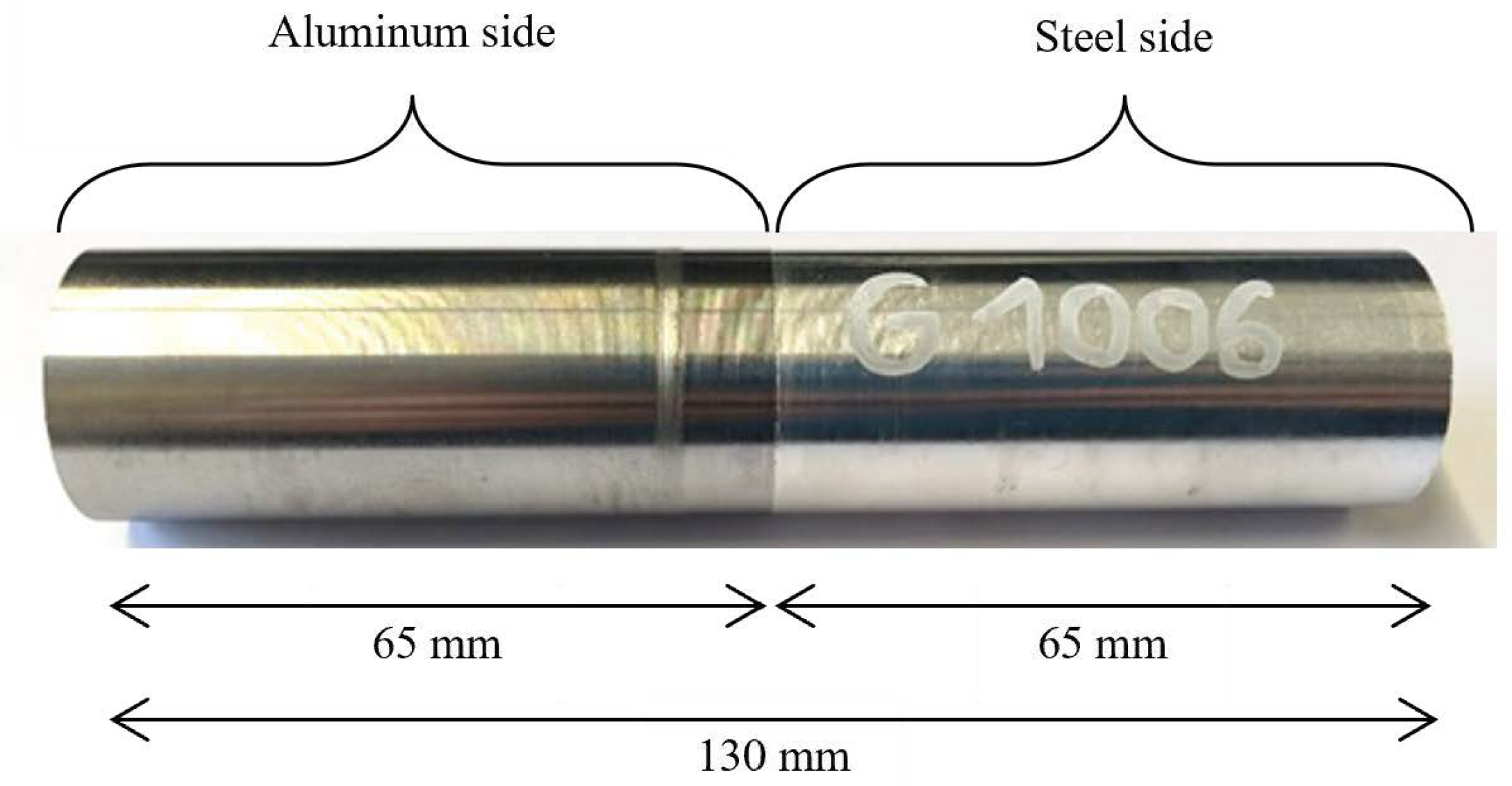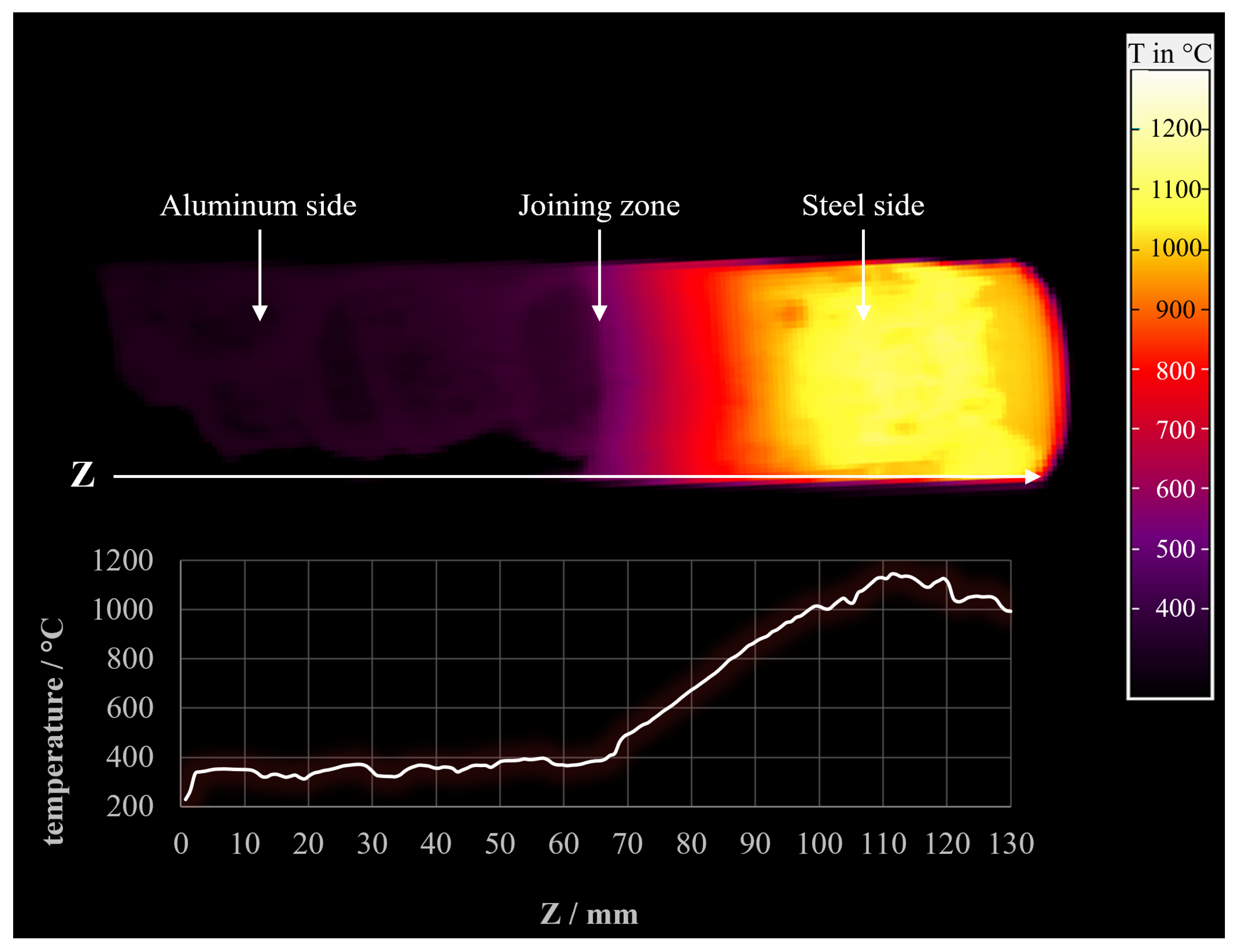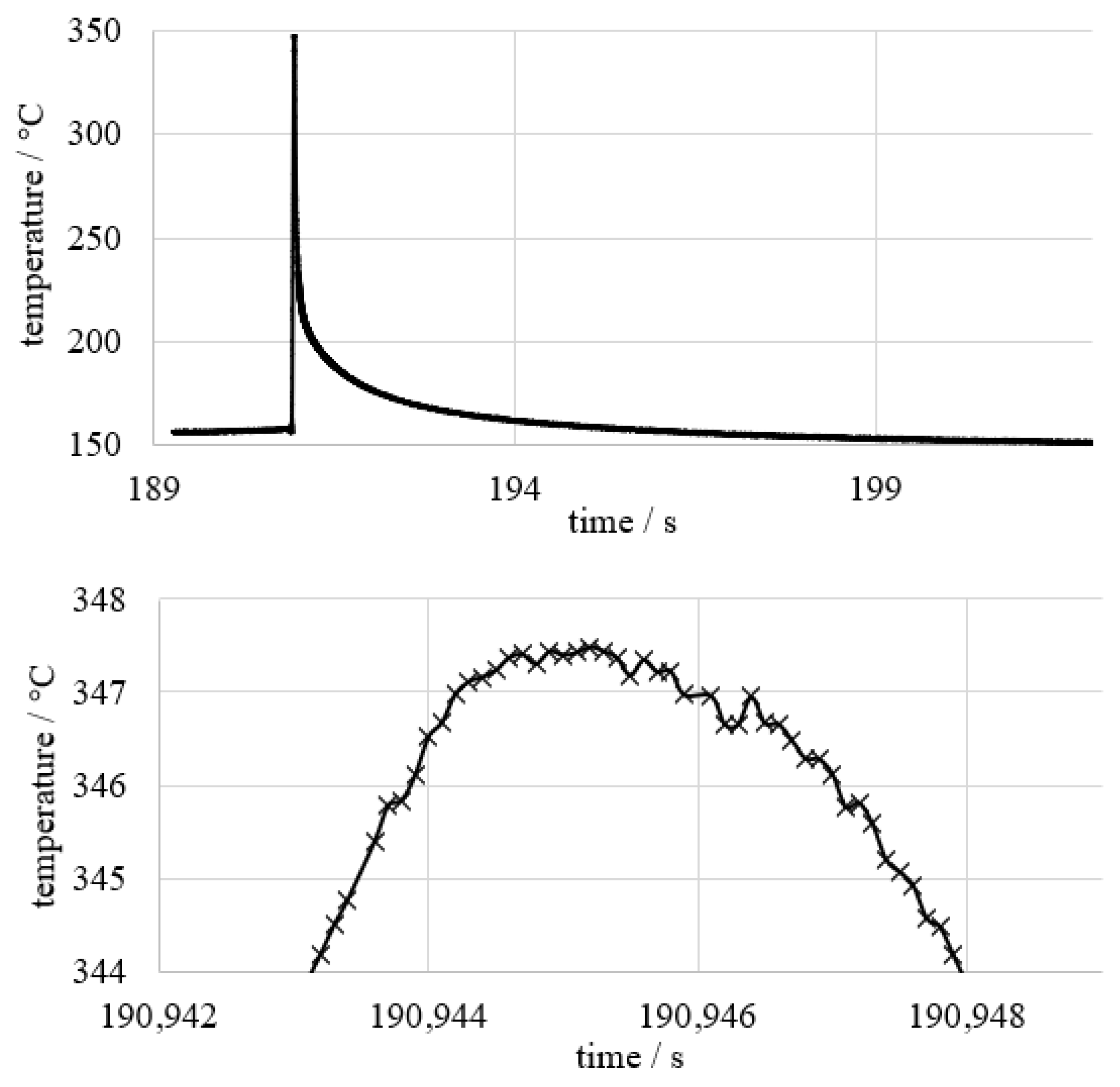Contact Temperature Measurements on Hybrid Aluminum–Steel Workpieces in a Cross-Wedge Rolling Process
Abstract
:1. Introduction
1.1. Research on Hybrid Materials and Inhomogeneous Heating
1.2. Cross-Wedge Rolling of Hybrid Components
1.3. Methods of Thermal Monitoring during Cross-Wedge Rolling
2. Materials and Methods
3. Results and Discussion
4. Further Research
Author Contributions
Funding
Data Availability Statement
Conflicts of Interest
Abbreviations
| CRC | Collaborative Research Center |
| CWR | Cross-Wedge Rolling |
References
- Buchmayr, B. Aktuelle Entwicklungstrends und zukünftige Herausforderungen im Bereich der Umformtechnik. BHM Berg- Hüttenmännische Monatshefte 2015, 27, 501–506. [Google Scholar] [CrossRef]
- Behrens, B.A.; Kosch, K.G. Development of the heating and forming strategy in compound forging of hybrid steel-aluminum parts. Mater. Werkst. 2011, 42, 973–978. [Google Scholar] [CrossRef]
- Cao, J.; Banu, M. Opportunities and Challenges in Metal Forming for Lightweighting: Review and Future Work. J. Manuf. Sci. Eng. 2020, 142, 110813. [Google Scholar] [CrossRef]
- Jank, N.; Staufer, H.; Bruckner, J. Schweißverbindungen von Stahl mit Aluminium–eine Perspektive für die Zukunft. BHM Berg- Hüttenmännische Monatshefte 2008, 153, 189–192. [Google Scholar] [CrossRef]
- Behrens, B.A.; Chugreev, A.; Selinski, M.; Matthias, T. Joining zone shape optimisation for hybrid components made of aluminium-steel by geometrically adapted joining surfaces in the friction welding process. AIP Conf. Proc. 2019, 2113, 040027. [Google Scholar] [CrossRef]
- Tanaka, T.; Nezu, M.; Uchida, S.; Hirata, T. Mechanism of intermetallic compound formation during the dissimilar friction stir welding of aluminum and steel. J. Mater. Sci. 2020, 55, 3064–3072. [Google Scholar] [CrossRef]
- Ambroziak, A.; Korzeniowski, M.; Kustron, P.; Winnicki, M.; Sokołowski, P.; Harapinska, E. Friction Welding of Aluminium and Aluminium Alloys with Steel. Adv. Mater. Sci. Eng. 2014, 2014, 981653. [Google Scholar] [CrossRef] [Green Version]
- Behrens, B.A.; Chugreev, A.; Matthias, T. Hybride Lagerbuchsen aus Aluminium und Stahl/Numerical process design for the production of a hybrid bearing bushing made of aluminium and steel. WT Werkstattstech. Online 2018, 108, 691–697. [Google Scholar] [CrossRef]
- Behrens, B.A.; Bouguecha, A.; Bonk, C.; Stonis, M.; Klose, C.; Blohm, T.; Chugreeva, A.; Duran, D.; Matthias, T.; Golovko, O.; et al. Aktuelle Forschungsschwerpunkte in der Massivumformung. In Proceedings of the 23rd Forming Technology Colloquium Hannover, Garbsen, Germany, 4 March 2020; pp. 15–31. [Google Scholar]
- Kruse, J.; Jagodzinski, A.; Langner, J.; Stonis, M.; Behrens, B.A. Investigation of the joining zone displacement of cross-wedge rolled serially arranged hybrid parts. Int. J. Mater. Form. 2020, 13, 577–589. [Google Scholar] [CrossRef]
- Leiber Group GmbH & Co. KG. Hybridschmieden für optimierten Leichtbau. Int. Alum. J. 2011, 87, 54. [Google Scholar]
- Tomczak, J.; Bulzak, T.; Pater, Z.; Wójcik, Ł.; Kusiak, T. Skew Rolling of Bimetallic Rods. Materials 2020, 14, 18. [Google Scholar] [CrossRef] [PubMed]
- Graf, M.; Härtel, S.; Binotsch, C.; Awiszus, B. Forging of Lightweight Hybrid Metallic-Plastic Components. Procedia Eng. 2017, 184, 497–505. [Google Scholar] [CrossRef]
- Jagodzinski, A.; Gerland, H.; Kriwall, M.; Langner, J.; Stonis, M.; Behrens, B.A. FE-Based Investigation on the Influence of Inhomogeneously Heated Billets on Subsequent Forging Processes. In Forming the Future: Proceedings of the 13th International Conference on the Technology of Plasticity; Springer: Berlin/Heidelberg, Germany, 2021; pp. 1107–1119. [Google Scholar] [CrossRef]
- Matzenmiller, A.; Bröcker, C. Thermo-mechanically coupled FE analysis and sensitivity study of simultaneous hot/cold forging process with local inductive heating and cooling. Int. J. Mater. Form. 2011, 5, 275–300. [Google Scholar] [CrossRef]
- Ennen, M.; Baake, E.; Niedzwiecki, I. Tailored Heating of Billets for Hot Forming Using an Induction Heating Approach. In Proceedings of the UIE 2021: XIX International UIE Congress on Evolution and New Trends in Electrothermal Processes, Pilsen, Czech Republic, 1–3 September 2021; pp. 61–62. [Google Scholar]
- Okman, O.; Özmen, M.; Huwiler, H.; Tekkaya, A. Free forming of locally heated specimens. Int. J. Mach. Tools Manuf. 2007, 47, 1197–1205. [Google Scholar] [CrossRef]
- Kayatürk, K. Simultaneous Hot and Cold Forging of Solid Cylinders. Master’s Thesis, Middle East Technical University, Ankara, Turkey, 2003. [Google Scholar]
- Yoshihara, S.; Nishimura, H.; Yamamoto, H.; Manabe, K.I. Formability enhancement in magnesium alloy stamping using a local heating and cooling technique: Circular cup deep drawing process. J. Mater. Process. Technol. 2003, 142, 609–613. [Google Scholar] [CrossRef]
- Kahrimanidis, A. Thermisch Unterstützte Umformung von Aluminiumblechen. Ph.D. Thesis, Friedrich-Alexander-Universität Erlangen-Nürnberg, Erlangen, Germany, 2016. [Google Scholar] [CrossRef]
- Herbertz, R.; Hermanns, H.; Labs, R. Massivumformung Kurz und Bündig; Industrieverband Massivumformung e.V.: Hagen, Germany, 2013. [Google Scholar]
- Doege, E.; Behrens, B. Handbuch Umformtechnik; VDI-Buch; Springer: Berlin/Heidelberg, Germany, 2010. [Google Scholar]
- Rudnev, V.I. Handbook of Induction Heating; CRC Press: Boca Raton, FL, USA, 2002; ISBN 978-1466553958. [Google Scholar]
- Glassmann, E. New Optical Pyrometer for Measuring the Temperature of Aluminum Alloys. In 3T—True Temperature Technologies; Theradion Industrial Park: Misgav, Israel, 1997. [Google Scholar]
- Yoneyama, T.; Tozawa, Y. Direct Measurement of Stress and Heat between Work and Tool in Metal Forming. CIRP Ann. 1990, 39, 219–222. [Google Scholar] [CrossRef]
- Yoneyama, T. Development of a friction sensor for hot forging. Int. J. Adv. Manuf. Technol. 2017, 90, 2251–2261. [Google Scholar] [CrossRef] [Green Version]
- Plogmeyer, M.; Kruse, J.; Stonis, M.; Paetsch, N.; Behrens, B.A.; Bräuer, G. Temperature measurement with thin film sensors during warm forging of steel. Microsyst. Technol. 2021, 27, 3841–3850. [Google Scholar] [CrossRef]






| Property | Iron | Aluminum | Unit |
|---|---|---|---|
| Density | 7.86 | 2.7 | g/cm |
| Thermal expansion (0–100 °C) | 12 | 24 | 10·m/(m·K) |
| Melting temperature | 1536 | 660 | °C |
Disclaimer/Publisher’s Note: The statements, opinions and data contained in all publications are solely those of the individual author(s) and contributor(s) and not of MDPI and/or the editor(s). MDPI and/or the editor(s) disclaim responsibility for any injury to people or property resulting from any ideas, methods, instructions or products referred to in the content. |
© 2023 by the authors. Licensee MDPI, Basel, Switzerland. This article is an open access article distributed under the terms and conditions of the Creative Commons Attribution (CC BY) license (https://creativecommons.org/licenses/by/4.0/).
Share and Cite
Merkel, P.; Kruse, J.; Kriwall, M.; Behrens, B.-A.; Stonis, M. Contact Temperature Measurements on Hybrid Aluminum–Steel Workpieces in a Cross-Wedge Rolling Process. J. Manuf. Mater. Process. 2023, 7, 130. https://doi.org/10.3390/jmmp7040130
Merkel P, Kruse J, Kriwall M, Behrens B-A, Stonis M. Contact Temperature Measurements on Hybrid Aluminum–Steel Workpieces in a Cross-Wedge Rolling Process. Journal of Manufacturing and Materials Processing. 2023; 7(4):130. https://doi.org/10.3390/jmmp7040130
Chicago/Turabian StyleMerkel, Paulina, Jens Kruse, Mareile Kriwall, Bernd-Arno Behrens, and Malte Stonis. 2023. "Contact Temperature Measurements on Hybrid Aluminum–Steel Workpieces in a Cross-Wedge Rolling Process" Journal of Manufacturing and Materials Processing 7, no. 4: 130. https://doi.org/10.3390/jmmp7040130







